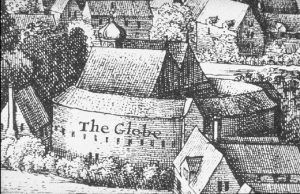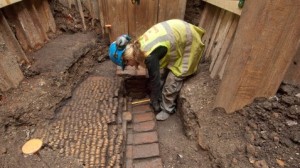by Stephanie Cowell
 Shakespeare’s Globe has been actually built three times…in 1599, in 1613 and after decades of struggle and huge architectural research, again on the south side of the Thames in 1995. But in 1599, it wasn’t really new because the actors salvaged the boards and galleries and perhaps even the hand-made nails from an earlier, much plainer theater (call the Theater) outside the northern walls of the city of London which was even then a very old city.
Shakespeare’s Globe has been actually built three times…in 1599, in 1613 and after decades of struggle and huge architectural research, again on the south side of the Thames in 1995. But in 1599, it wasn’t really new because the actors salvaged the boards and galleries and perhaps even the hand-made nails from an earlier, much plainer theater (call the Theater) outside the northern walls of the city of London which was even then a very old city.
The young men who built it were daring visionaries; they risked themselves financially in the days when an unpaid bill could often mean the stinking rat-filled pestilence of debtor’s prison. Theater companies bankrupt and disbanded; actors languished incarcerated until someone somehow paid their debt.
I have a great personal interest in the history of building the Globe; I always felt I somehow belonged back there. When I first traveled to London I crossed the river to Bankside and wandered among warehouses and other sad buildings until I found a single solitary plaque marking where the great Globe had stood in 1613. And I wrote two novels centering on it, and am in the midst of a third one so the Globe is very much in my heart.
Theater as we know it had only emerged perhaps twenty years before the foundation of the Globe was laid and there were a number of other roughly-raised playhouses (also used for bear baiting and other things) already in London. It was in approximately 1593 (give or take a year) that the gifted young poet Shakespeare from Stratford-on-Avon likely arrived in the city and began working as a reviser/enhancer of older rougher plays and gradually joined a group of actors who would work with him all his life. It is hard to recreate in our minds how young and excited they all were. Elizabeth the Queen, a woman not yet old who loved to dance the night away, loved theater and noblemen wishing to please her patronized acting troupes to play in the city and before her.
But the lease on the land of the original Theater had ended in 1598, and so the company of theater men (then called the Lord Chamberlain’s Men, of which Shakespeare was a partial owner) rented land in the south side of the Thames, tore down the Theater, and carted whatever bricks or stone or gallery rail or wooden door they could over the frozen river and began to reshape it to the Globe.
The Globe opened in 1599. We have only a few rough pictures of the exterior and none of the interior, but following Elizabethan’s love of carved and painted and gilded wood, it must have been a beautiful sight. Legend has it that it opened with Shakespeare’s marvelously patriotic Henry V. Undoubtedly, Richard Burbage, one of the two most beloved actors on the Elizabethan stage, played Henry.
They had fourteen years of glory: during those years, Shakespeare wrote Julius Caesar, As You Like It, Twelfth Night, Hamlet, Othello, King Lear, and The Tempest, among many other plays. The theater changed plays regularly and ran them in repertory: some of Shakespeare’s contemporaries were Ben Jonson, Beaumont and Fletcher, Massinger, Dekker, Middleton, and so on.
Theater was a risky business I said: at any time the actors were concerned that the plague or the Puritans of any other piece of very back luck would shut them down. But it was fire which ended them in 1613. A cannon shot set off sparks in the thatched half-roof of the theater and though the Globe was quickly evacuated and no one was hurt (and they did not even have EXIT signs in those days!) the exquisite theater burned to the ground. Were Shakespeare’s original playscripts in there when it burned?
The sharers rebuilt it but the glory days had passed. Shakespeare shortly retired to Stratford and died there at the age of 52 in 1616. The era of the great outdoor theaters was coming to an end; though the second Globe lasted nearly thirty years, I find most scholars say little about it. Theater had moved indoors, to the Blackfriars Playhouse to name one theater.
The new Globe lingered until 1642 when the Puritans seized Parliament, closed all theaters as being sinful and pulled it to the ground. It would not rise again for another three hundred and fifty years by another young actor with a vision. But that is another and even more wonderful story playing out even now.
You do not have to wander narrow, desolate alleys anymore on Bankside to find the Globe.
____________________________
About the author: Historical novelist Stephanie Cowell is the author of Nicholas Cooke, The Physician of London, The Players: a novel of the young Shakespeare, Marrying Mozart and Claude & Camille: a novel of Monet. She is the recipient of the American Book Award. Her work has been translated into nine languages. Stephanie is currently finishing two novels, one on the love story of Elizabeth Barrett and Robert Browning, and the second about the year Shakespeare wrote Hamlet. Her website is http://www.stephaniecowell.com


